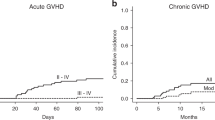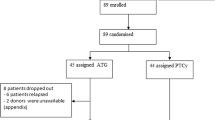Abstract
We describe 47 patients with lymphoma and failed prior autologous hematopoietic cell transplantation (HCT) who received TLI-ATG (anti-thymocyte globulin) conditioning followed by allogeneic HCT. Thirty-two patients had non-Hodgkin lymphoma (NHL; diffuse large B-cell lymphoma (n=19), T-cell NHL (n=6), mantle cell lymphoma (n=4) or other B-cell subtypes (n=3)), and 15 had Hodgkin lymphoma. The median follow-up was 4.9 (range, 2.1–11.9) years. The cumulative incidence of grade II–IV acute GvHD at day +100 was 12%, and the cumulative incidence of extensive chronic GvHD at 1 year was 36%. The 3-year cumulative incidences of overall survival (OS), PFS and non-relapse mortality (NRM) were 81%, 44% and 7%, respectively. Fifteen patients died (relapse, n=10; NRM, n=5). Among the 25 patients with relapse after allogeneic HCT, 11 (44%) achieved durable (>1 year) CRs following donor lymphocyte infusion or chemoradiotherapy. The majority of surviving patients (75%; n=24) were able to discontinue all immunosuppression. For patients with relapsed lymphoma after autologous HCT, allogeneic HCT using TLI-ATG conditioning is a well-tolerated, predominantly outpatient therapy with low NRM (7% at 3 years), a low incidence of GvHD, durable disease control and excellent OS (81% at 3 years).
This is a preview of subscription content, access via your institution
Access options
Subscribe to this journal
Receive 12 print issues and online access
$259.00 per year
only $21.58 per issue
Buy this article
- Purchase on Springer Link
- Instant access to full article PDF
Prices may be subject to local taxes which are calculated during checkout




Similar content being viewed by others
References
Schouten HC, Qian W, Kvaloy S, Porcellini A, Hagberg H, Johnsen HE et al. High-dose therapy improves progression-free survival and survival in relapsed follicular non-Hodgkin's lymphoma: results from the randomized European CUP trial. J Clin Oncol 2003; 21: 3918–3927.
Linch DC, Winfield D, Goldstone AH, Moir D, Hancock B, McMillan A et al. Dose intensification with autologous bone-marrow transplantation in relapsed and resistant Hodgkin's disease: results of a BNLI randomised trial. Lancet 1993; 341: 1051–1054.
Philip T, Guglielmi C, Hagenbeek A, Somers R, Van der Lelie H, Bron D et al. Autologous bone marrow transplantation as compared with salvage chemotherapy in relapses of chemotherapy-sensitive non-Hodgkin's lymphoma. N Engl J Med 1995; 333: 1540–1545.
Calvo-Villas JM, Martin A, Conde E, Pascual A, Heras I, Varela R et al. Effect of addition of rituximab to salvage chemotherapy on outcome of patients with diffuse large B-cell lymphoma relapsing after an autologous stem-cell transplantation. Ann Oncol 2010; 21: 1891–1897.
Bishop MR, Dean RM, Steinberg SM, Odom J, Pavletic SZ, Chow C et al. Clinical evidence of a graft-versus-lymphoma effect against relapsed diffuse large B-cell lymphoma after allogeneic hematopoietic stem-cell transplantation. Ann Oncol 2008; 19: 1935–1940.
Khouri IF, Saliba RM, Erwin WD, Samuels BI, Korbling M, Medeiros LJ et al. Nonmyeloablative allogeneic transplantation with or without 90yttrium ibritumomab tiuxetan is potentially curative for relapsed follicular lymphoma: 12-year results. Blood 2012; 119: 6373–6378.
Rezvani AR, Storer B, Maris M, Sorror ML, Agura E, Maziarz RT et al. Nonmyeloablative allogeneic hematopoietic cell transplantation in relapsed, refractory, and transformed indolent non-Hodgkin's lymphoma. J Clin Oncol 2008; 26: 211–217.
Rezvani AR, Norasetthada L, Gooley T, Sorror M, Bouvier ME, Sahebi F et al. Non-myeloablative allogeneic haematopoietic cell transplantation for relapsed diffuse large B-cell lymphoma: a multicentre experience. Br J Haematol 2008; 143: 395–403.
Thomson KJ, Morris EC, Bloor A, Cook G, Milligan D, Parker A et al. Favorable long-term survival after reduced-intensity allogeneic transplantation for multiple-relapse aggressive non-Hodgkin's lymphoma. J Clin Oncol 2009; 27: 426–432.
Peniket AJ, Ruiz de Elvira MC, Taghipour G, Cordonnier C, Gluckman E, de Witte T et al. An EBMT registry matched study of allogeneic stem cell transplants for lymphoma: allogeneic transplantation is associated with a lower relapse rate but a higher procedure-related mortality rate than autologous transplantation. Bone Marrow Transplant 2003; 31: 667–678.
Lazarus HM, Zhang MJ, Carreras J, Hayes-Lattin BM, Ataergin AS, Bitran JD et al. A comparison of HLA-identical sibling allogeneic versus autologous transplantation for diffuse large B cell lymphoma: a report from the CIBMTR. Biol Blood Marrow Transplant 2010; 16: 35–45.
Bacher U, Klyuchnikov E, Le-Rademacher J, Carreras J, Armand P, Bishop MR et al. Conditioning regimens for allotransplants for diffuse large B-cell lymphoma: myeloablative or reduced intensity? Blood 2012; 120: 4256–4262.
van Kampen RJ, Canals C, Schouten HC, Nagler A, Thomson KJ, Vernant JP et al. Allogeneic stem-cell transplantation as salvage therapy for patients with diffuse large B-cell non-Hodgkin's lymphoma relapsing after an autologous stem-cell transplantation: an analysis of the European Group for Blood and Marrow Transplantation Registry. J Clin Oncol 2011; 29: 1342–1348.
van Besien K, Loberiza FR Jr., Bajorunaite R, Armitage JO, Bashey A, Burns LJ et al. Comparison of autologous and allogeneic hematopoietic stem cell transplantation for follicular lymphoma. Blood 2003; 102: 3521–3529.
Gajewski JL, Phillips GL, Sobocinski KA, Armitage JO, Gale RP, Champlin RE et al. Bone marrow transplants from HLA-identical siblings in advanced Hodgkin's disease. J Clin Oncol 1996; 14: 572–578.
Radich JP, Gooley T, Sanders JE, Anasetti C, Chauncey T, Appelbaum FR . Second allogeneic transplantation after failure of first autologous transplantation. Biol Blood Marrow Transplant 2000; 6: 272–279.
Tsai T, Goodman S, Saez R, Schiller G, Adkins D, Callander N et al. Allogeneic bone marrow transplantation in patients who relapse after autologous transplantation. Bone Marrow Transplant 1997; 20: 859–863.
McSweeney PA, Niederwieser D, Shizuru JA, Sandmaier BM, Molina AJ, Maloney DG et al. Hematopoietic cell transplantation in older patients with hematologic malignancies: replacing high-dose cytotoxic therapy with graft-versus-tumor effects. Blood 2001; 97: 3390–3400.
Nagler A, Slavin S, Varadi G, Naparstek E, Samuel S, Or R . Allogeneic peripheral blood stem cell transplantation using a fludarabine-based low intensity conditioning regimen for malignant lymphoma. Bone Marrow Transplant 2000; 25: 1021–1028.
Morris E, Thomson K, Craddock C, Mahendra P, Milligan D, Cook G et al. Outcomes after alemtuzumab-containing reduced-intensity allogeneic transplantation regimen for relapsed and refractory non-Hodgkin lymphoma. Blood 2004; 104: 3865–3871.
Khouri IF, Saliba RM, Giralt SA, Lee MS, Okoroji GJ, Hagemeister FB et al. Nonablative allogeneic hematopoietic transplantation as adoptive immunotherapy for indolent lymphoma: low incidence of toxicity, acute graft-versus-host disease, and treatment-related mortality. Blood 2001; 98: 3595–3599.
Corradini P, Tarella C, Olivieri A, Gianni AM, Voena C, Zallio F et al. Reduced-intensity conditioning followed by allografting of hematopoietic cells can produce clinical and molecular remissions in patients with poor-risk hematologic malignancies. Blood 2002; 99: 75–82.
Sorror ML, Storer BE, Maloney DG, Sandmaier BM, Martin PJ, Storb R . Outcomes after allogeneic hematopoietic cell transplantation with nonmyeloablative or myeloablative conditioning regimens for treatment of lymphoma and chronic lymphocytic leukemia. Blood 2008; 111: 446–452.
Lowsky R, Takahashi T, Liu YP, Dejbakhsh-Jones S, Grumet FC, Shizuru JA et al. Protective conditioning for acute graft-versus-host disease. N Engl J Med 2005; 353: 1321–1331.
Kohrt HE, Turnbull BB, Heydari K, Shizuru JA, Laport GG, Miklos DB et al. TLI and ATG conditioning with low risk of graft-versus-host disease retains antitumor reactions after allogeneic hematopoietic cell transplantation from related and unrelated donors. Blood 2009; 114: 1099–1109.
Cheson BD, Pfistner B, Juweid ME, Gascoyne RD, Specht L, Horning SJ et al. Revised response criteria for malignant lymphoma. J Clin Oncol 2007; 25: 579–586.
Wolden SL, Tate DJ, Hunt SA, Strober S, Hoppe RT . Long-term results of total lymphoid irradiation in the treatment of cardiac allograft rejection. Int J Radiat Oncol Biol Phys 1997; 39: 953–960.
Millan MT, Shizuru JA, Hoffmann P, Dejbakhsh-Jones S, Scandling JD, Grumet FC et al. Mixed chimerism and immunosuppressive drug withdrawal after HLA-mismatched kidney and hematopoietic progenitor transplantation. Transplantation 2002; 73: 1386–1391.
Baron F, Sandmaier BM . Chimerism and outcomes after allogeneic hematopoietic cell transplantation following nonmyeloablative conditioning. Leukemia 2006; 20: 1690–1700.
Filipovich AH, Weisdorf D, Pavletic S, Socie G, Wingard JR, Lee SJ et al. National Institutes of Health consensus development project on criteria for clinical trials in chronic graft-versus-host disease: I. Diagnosis and staging working group report. Biol Blood Marrow Transplant 2005; 11: 945–956.
Shulman HM, Kleiner D, Lee SJ, Morton T, Pavletic SZ, Farmer E et al. Histopathologic diagnosis of chronic graft-versus-host disease: National Institutes of Health Consensus Development Project on Criteria for Clinical Trials in Chronic Graft-versus-Host Disease: II. Pathology Working Group Report. Biol Blood Marrow Transplant 2006; 12: 31–47.
Rodriguez R, Nademanee A, Ruel N, Smith E, Krishnan A, Popplewell L et al. Comparison of reduced-intensity and conventional myeloablative regimens for allogeneic transplantation in non-Hodgkin's lymphoma. Biol Blood Marrow Transplant 2006; 12: 1326–1334.
Sureda A, Robinson S, Canals C, Carella AM, Boogaerts MA, Caballero D et al. Reduced-intensity conditioning compared with conventional allogeneic stem-cell transplantation in relapsed or refractory Hodgkin's lymphoma: an analysis from the Lymphoma Working Party of the European Group for Blood and Marrow Transplantation. J Clin Oncol 2008; 26: 455–462.
Anderlini P, Saliba R, Acholonu S, Okoroji GJ, Donato M, Giralt S et al. Reduced-intensity allogeneic stem cell transplantation in relapsed and refractory Hodgkin's disease: low transplant-related mortality and impact of intensity of conditioning regimen. Bone Marrow Transplant 2005; 35: 943–951.
Khouri IF, McLaughlin P, Saliba RM, Hosing C, Korbling M, Lee MS et al. Eight-year experience with allogeneic stem cell transplantation for relapsed follicular lymphoma after nonmyeloablative conditioning with fludarabine, cyclophosphamide, and rituximab. Blood 2008; 111: 5530–5536.
Escalon MP, Champlin RE, Saliba RM, Acholonu SA, Hosing C, Fayad L et al. Nonmyeloablative allogeneic hematopoietic transplantation: a promising salvage therapy for patients with non-Hodgkin's lymphoma whose disease has failed a prior autologous transplantation. J Clin Oncol 2004; 22: 2419–2423.
Burroughs LM, O'Donnell PV, Sandmaier BM, Storer BE, Luznik L, Symons HJ et al. Comparison of outcomes of HLA-matched related, unrelated, or HLA-haploidentical related hematopoietic cell transplantation following nonmyeloablative conditioning for relapsed or refractory Hodgkin lymphoma. Biol Blood Marrow Transplant 2008; 14: 1279–1287.
Hari P, Carreras J, Zhang MJ, Gale RP, Bolwell BJ, Bredeson CN et al. Allogeneic transplants in follicular lymphoma: higher risk of disease progression after reduced-intensity compared to myeloablative conditioning. Biol Blood Marrow Transplant 2008; 14: 236–245.
Messina G, Giaccone L, Festuccia M, Irrera G, Scortechini I, Sorasio R et al. Multicenter experience using total lymphoid irradiation and antithymocyte globulin as conditioning for allografting in hematological malignancies. Biol Blood Marrow Transplant 2012; 18: 1600–1607.
Baron F, Zachee P, Maertens J, Kerre T, Ory A, Seidel L et al. Non-myeloablative allogeneic hematopoietic cell transplantation following fludarabine plus 2 Gy TBI or ATG plus 8 Gy TLI: a phase II randomized study from the Belgian Hematological Society. J Hematol Oncol 2015; 8: 4.
Benjamin J, Laport GG, Tate K, Galvez L, Armstrong R, Sheehan K et al. Early Infusion Of Donor-Derived CIK Cells As Consolidative Immunotherapy Following Non-Myeloablative Allogeneic Transplantation: Safety and Feasibility (Abstract #899). American Society of Hematology Annual Meeting. New Orleans, LA, 2013.
Acknowledgements
This study was funded by P01 CA049605 and P01 HL075462 (National Institutes of Health, Bethesda, MD). ARR is supported by a Mentored Research Scholar Grant (12-162-01-LIB) from the American Cancer Society. The study design was conceived by RL and SS Statistical analysis was performed by ARR and BE. The manuscript was drafted by ARR, ASK and RL, and all authors participated in revising the manuscript. All authors participated in data collection and analysis, and all authors approved the submitted manuscript.
Author information
Authors and Affiliations
Corresponding author
Ethics declarations
Competing interests
JEB was a faculty member at Stanford University during the time that this research was conducted, but is now an employee of Amgen. The remaining authors declare no conflict of interest.
Rights and permissions
About this article
Cite this article
Rezvani, A., Kanate, A., Efron, B. et al. Allogeneic hematopoietic cell transplantation after failed autologous transplant for lymphoma using TLI and anti-thymocyte globulin conditioning. Bone Marrow Transplant 50, 1286–1292 (2015). https://doi.org/10.1038/bmt.2015.149
Received:
Revised:
Accepted:
Published:
Issue Date:
DOI: https://doi.org/10.1038/bmt.2015.149
This article is cited by
-
Outcomes of diffuse large B-cell lymphoma patients relapsing after autologous stem cell transplantation: an analysis of patients included in the CORAL study
Bone Marrow Transplantation (2017)
-
Allogeneic Stem Cell Transplantation for Non-Hodgkin Lymphoma
Current Hematologic Malignancy Reports (2016)



